

Math Project answets. Question Paper. Math ATT vid. Logarithms - Topics in precalculus. Algebra - Exponential and Logarithm Functions. In this chapter we are going to look at exponential and logarithm functions.
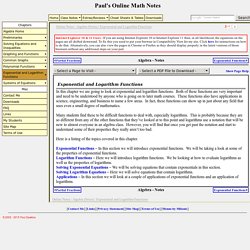
Both of these functions are very important and need to be understood by anyone who is going on to later math courses. These functions also have applications in science, engineering, and business to name a few areas. In fact, these functions can show up in just about any field that uses even a small degree of mathematics. Many students find these to be difficult functions to deal with, especially logarithms. This is probably because they are so different from any of the other functions that they’ve looked at to this point and logarithms use a notation that will be new to almost everyone in an algebra class. Here is a listing of the topics covered in this chapter. Exponential Functions In this section we will introduce exponential functions.
Logarithm Functions Here we will introduce logarithm functions. Solving Exponential Equations We will be solving equations that contain exponentials in this section. Lesson LOGARITHMS AND EXPONENTIAL AND LOGARITHMIC EQUATIONS. This lesson covers an overview of LOGARITHMS AND EXPONENTIAL AND LOGARITHMIC EQUATIONS Logarithmic Equations and Exponential Equations are two sides of the same coin.
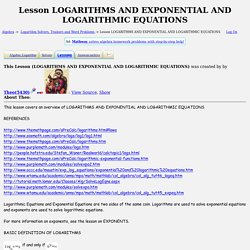
Logarithms are used to solve exponential equations and exponents are used to solve logarithmic equations. For more information on exponents, see the lesson on EXPONENTS. if and only if This means that the log of x to the base b equals y if and only if the base b raised to the power of the exponent y = x. Example: let b = 2 and x = 8 and y = 3 This means that the log of 8 to the base 2 = 3 if and only if 2 raised to the third power = 8. Since , this is confirmed to be true. There are three major rules of logarithms. The Change-of-Base Formula. The Change-of-Base Formula (page 5 of 5) Sections: Basic log rules, Expanding, Simplifying, Trick questions, Change-of-Base formula There is one other log "rule", but it's more of a formula than a rule.
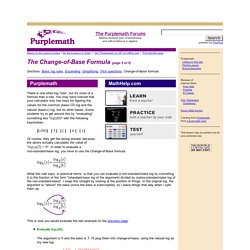
You may have noticed that your calculator only has keys for figuring the values for the common (base-10) log and the natural (base-e) log, but no other bases. Some students try to get around this by "evaluating" something like "log3(6)" with the following keystrokes: Of course, they get the wrong answer, because the above actually calculates the value of "log10(3) × 6".
What this rule says, in practical terms, is that you can evaluate a non-standard-base log by converting it to the fraction of the form "(standard-base log of the argument) divided by (same-standard-base log of the non-standard-base)". This is how you would evaluate the last example on the previous page: Evaluate log3(6). Basic idea and rules for logarithms - Math Insight. The basic idea A logarithm is the opposite of a power.

In other words, if we take a logarithm of a number, we undo an exponentiation. Let's start with simple example. If we take the base and raise it to the power of , we have the expression . The result is some number, we'll call it , defined by . Let's say I didn't tell you what the exponent was. From the above calculation, we already know that . A logarithm is a function that does all this work for you. Logarithmic and exponential functions - Topics in precalculus.
Exponential functions Inverse relations Exponential and logarithmic equations Creating one logarithm from a sum THE LOGARITHMIC FUNCTION WITH BASE b is the function y = logb x. b is normally a number greater than 1 (although it need only be greater than 0 and not equal to 1).
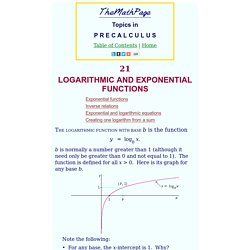
Note the following: • For any base, the x-intercept is 1. To see the answer, pass your mouse over the colored area. The logarithm of 1 is 0. y = logb1 = 0. Logarithms: Introduction to "The Relationship". Purplemath offers a complete lessonon the topic you have selected.Try the lesson below!
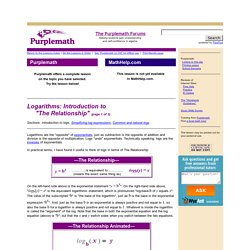
This lesson is not yet availablein MathHelp.com. Logarithms: Introduction to "The Relationship" (page 1 of 3) Sections: Introduction to logs, Simplifying log expressions, Common and natural logs.